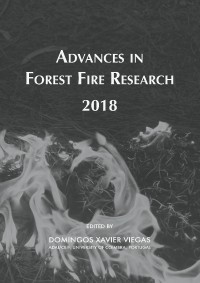Please use this identifier to cite or link to this item:
https://hdl.handle.net/10316.2/44571| DC Field | Value | Language |
|---|---|---|
| dc.contributor.author | Jiménez-Ruano, Adrián | |
| dc.contributor.author | Rodrigues Mimbrero, Marcos | |
| dc.contributor.author | Riva Fernández, Juan de la | |
| dc.date.accessioned | 2018-11-09T13:20:36Z | |
| dc.date.accessioned | 2020-09-06T17:31:27Z | - |
| dc.date.available | 2018-11-09T13:20:36Z | |
| dc.date.available | 2020-09-06T17:31:27Z | - |
| dc.date.issued | 2018 | - |
| dc.identifier.isbn | 978-989-26-16-506 (PDF) | |
| dc.identifier.uri | https://hdl.handle.net/10316.2/44571 | - |
| dc.description.abstract | Defining pyro-regions, i.e., of homogenous zones of fire activity, is an on-going task in Spain with few case studies in the literature. Their characterisation and understanding is a crucial step towards improving forest fire management and prevention. It is widely agreed that fire activity is non-stationary. Several works already report temporal dynamics in fire frequency and burned area. In this work we propose a spatial-temporal approach to define pyro-regions considering both structural and temporal fire behaviour using historical fire records from the EGIF database. A combination of Self Organizing Maps (SOM) and hierarchical clustering is applied to time series (1974-2015) of fire regime features: number/burned area of summer fires, number/burned area of large fires (>500 ha), number/burned area of natural fires, number/burned area of winter fires and number of small fires (<1 ha). The structural component of fire activity is computed as the average value whereas the temporal evolution is addressed by means of Sen’s slope. Prior to cluster analysis, fire features were submitted to Principal Component Analysis with Varimax rotation. Eigenvalues were then pre-classified using SOM. Subsequently, hierarchical clustering was applied to SOM outputs. We obtained a set of 4 structural clusters relating to increased number of fires; low fire incidence, slightly linked to winter season; large and natural fires; and moderate impact of human-related large fires mainly. The process was repeated using Sen’s slope to build the dynamic component, ultimately characterised by: highly dynamic winter with increased in summer frequency; increased summer burned area and natural fires; and small fires; and no trend. | eng |
| dc.language.iso | eng | - |
| dc.publisher | Imprensa da Universidade de Coimbra | por |
| dc.relation.ispartof | http://hdl.handle.net/10316.2/44517 | por |
| dc.rights | open access | - |
| dc.subject | forest fires | eng |
| dc.subject | pyro-regions | eng |
| dc.subject | Sen’s Slope | eng |
| dc.subject | SOM | eng |
| dc.subject | hierarchical clustering | eng |
| dc.subject | Spain | eng |
| dc.title | Identifying pyroregions by means of Self Organizing Maps and hierarchical clustering algorithms in mainland Spain | por |
| dc.type | bookPart | por |
| uc.publication.firstPage | 495 | - |
| uc.publication.lastPage | 505 | - |
| uc.publication.location | Coimbra | por |
| dc.identifier.doi | 10.14195/978-989-26-16-506_54 | - |
| uc.publication.section | Chapter 3 - Fire Management | por |
| uc.publication.digCollection | PB | por |
| uc.publication.orderno | 54 | - |
| uc.publication.area | Ciências da Engenharia e Tecnologias | por |
| uc.publication.bookTitle | Advances in forest fire research 2018 | - |
| uc.publication.manifest | https://dl.uc.pt/json/iiif/10316.2/44571/204163/manifest?manifest=/json/iiif/10316.2/44571/204163/manifest | - |
| uc.publication.thumbnail | https://dl.uc.pt/retrieve/11058413 | - |
| uc.publication.parentItemId | 55072 | - |
| uc.itemId | 68835 | - |
| item.grantfulltext | open | - |
| item.fulltext | With Fulltext | - |
| Appears in Collections: | Advances in forest fire research 2018 | |
Files in This Item:
| File | Description | Size | Format | |
|---|---|---|---|---|
| identifying_pyroregions_by_means_of_self_organizing_maps.pdf | 1.35 MB | Adobe PDF |  |
Items in DSpace are protected by copyright, with all rights reserved, unless otherwise indicated.
